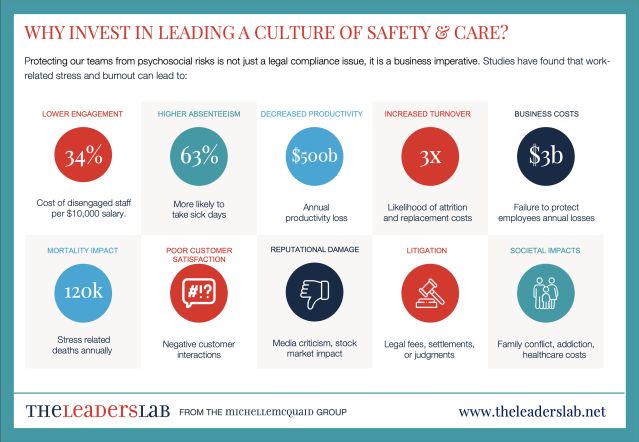Do your leaders understand the need for trust in the workplace? With the costs of burnout starting to add up to billions of dollars each year, new global standards and local regulations are providing workplaces with better guidance and greater accountability to care for the mental health and well-being of their people.
Despite these changes, some board members and senior leaders remain skeptical about the business case for minimizing emotional and social hazards and hope that simply promoting workplace well-being will be enough. However, new data suggests that protecting your people from psychological and social risks is not just a safety compliance requirement; it is a business imperative.

Source: Michelle McQuaid/ The Leaders Lab
For example, studies have found that work-related stress and burnout can lead to:
- Lower levels of engagement — Gallup estimates that disengaged staff cost $3,400 out of every $10,000 in salary they are paid.
- Increased absenteeism — Physical symptoms, such as headaches, muscle pain, and fatigue, and psychological symptoms, such as depression and anxiety, make people 63 percent more likely to take sick days.
- Increased compensation claims and medical expenses — A Stanford Graduate School of Business study found that workplace stress in America contributes to at least 120,000 deaths each year and accounts for up to $190 billion in healthcare costs.
- Decreased productivity — Researchers have found high levels of stress can temporarily impair strategic thinking, dull creative abilities, and make it hard to focus and complete tasks. It can also lead to an increase in mistakes, errors, and accidents. One study in 2017 of over 17,000 employees across 19 industries suggested stress costs U.S. employers an estimated 500 billion dollars in lost productivity annually.
- Lower levels of customer satisfaction — When people experience higher levels of job stress and emotional exhaustion, studies have found they are more likely to engage in negative behaviors towards customers, such as being rude or dismissive, leaving customers more likely to have negative perceptions of the business and less likely to make repeat purchases.
- Increased turnover — People are nearly three times as likely to leave their jobs, which results in additional costs for recruiting and training new employees.
- Litigation — Legal fees, expert witness fees, discovery costs, and potential settlement or judgment costs can make the litigation of psychological and social hazards incredibly expensive. For example, an American federal jury awarded $168 million in damages to a former employee of a healthcare provider who alleged that she was subjected to severe and pervasive sexual harassment and discrimination on the job.
- Reputational damage — Workplaces that are seen as unresponsive or unwilling to address psychological and social hazards can suffer significant damage to their reputation and brand if these issues become public. For example, Uber’s poor handling of sexual harassment and work design complaints have led to widespread media and social media criticism, 200,000 customers deleting their Uber accounts, large numbers of employee resignations, legal class actions, government investigations, and a lack of stock market confidence.
To put these very real business challenges into perspective, researchers estimate that burnout costs U.S. employers around $300 billion each year. And preliminary research shows that Australian businesses lose over $6.5 billion each year by failing to provide early intervention and treatment for their employees.
In addition, psychological and social injuries have been found to be related to increased work-family conflict, family breakdown, suicide, abuse of medications, and healthcare costs. In 2008, the annual cost to society (including the cost of mental healthcare, social service costs, and other costs) of work-related stress and stress-related illness in Canada was estimated to be $2.75 billion for a low prevalence of stress and $8.25 billion for a higher estimated prevalence.
Do your leaders understand the business, compliance, and human case for trust and safety in your workplace? How are you helping to put these issues onto their agendas?



















+ There are no comments
Add yours